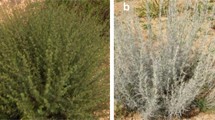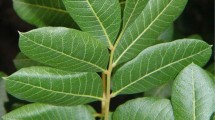Abstract
For the first time the elemental composition of Tanacetum corymbosum (L.) Sch. Bip. of Moldavian origin was determined by means of neutron activation analysis. The content of 21 major and trace elements Al, As, Br, Ca, Cl, Co,Cs, Fe, K, La, Mg, Mn, Mo, Na, Rb, Sb, Sc, Sm, Sr, Th, and Zn were determined. The content of As in analysed plants was lower than value established by World Health Organization. Obtained results were compared with literature data as well as Reference plant values. Concentration of elements determined in T. corymbosum fell within the values reported for other medicinal herbs of Asteraceae family.


Similar content being viewed by others
References
Bremer K, Humphries CJ (1993) Generic monograph of the Asteraceae-Anthemideae. Bull Nat Hist Mus Lond 23:71–177
Heywood VH (1976) Tanacetum L. In: Tutin TG, Heywood VH, Burges NA, Moore DM, Valentine DH, Walters SM, Webb DA (eds) Flora Europaea, Plantaginaceae to Compositae (and Rubiaceae), vol 4. Cambridge University Press, Cambridge, pp 169–171
Negru A (2007) Determinator de plante din flora Republicii Moldova. Chişinău: Ed. Universul p. 249. (in Romanian)
Özbilgin S, Akkol EK, ÖzB Ergene, Ilhan M, Saltan G, Acıkara ÖB, Tekin M, Keleş H, Süntar I (2018) In vivo activity assessment of some Tanacetum species used as traditional wound healer along with identification of the phytochemical profile by a new validated HPLC method. Iran J Basic Med Sci 21(2):145–152
Дикopacтyщиe пoлeзныe pacтeния Poccии (2001)/Oтв. peд. Бyдaнцeв AЛ, Лecиoвcкaя EE. CПб.: Издaтeльcтвo CПXФA, cтp. 117–118. (in Russian)
Brewer JG (1968) Flowering and seed setting in pyrethrum (Chrysanthemum cinerariae folium Vis.). Pyrethrum Post 9(4):18–21
Kumar V, Sharma Y (2016) Chemical composition and antibacterial activity of essential oils of Tanacetum longifolium. Int J Micorbiol App Sci 5(10):836–841
Todorova M, Evstatieva L (2014) Comparative study of Tanacetum species growing in Bulgaria. Zeitschrift für Naturforschung C 56(7–8):506–512
Pareek A, Suthar M, Rathore GS, Bansal V (2011) Feverfew (Tanacetum parthenium L.): a systematic review. Pharmacogn Rev 5(9):103–110
Kumar V, Tyagi D (2013) Chemical composition and biological activities of essential oils of genus Tanacetum: a review. J Pharmacogn Phytochem 2(3):159–163
Ivanescu B, Tuchilus C, Corciova A, Lungu C, Mihai TC, Gheldiu AM, Vlase L (2018) Antioxidant, antimicrobial cytotoxic activity of Tanacetum vulgare, Tanacetum corymbosum and Tanacetum macrophyllum extracts. Farmacia 66(2):282–288
Zinicovscaia I, Aničić Urošević M, Vergel K, Vieru E, Frontasyeva M, Povar I, Duca Gh (2018) Active moss biomonitoring of trace elements with Sphagnum girgensohnii in relation to atmospheric bulk deposition: chisinau case study. Ecol Chem Eng S 25(3):361–372
Zinicovscaia I, Sturza R, Gurmeza I, Vergel K, Gundorina S, Duca Gh (2018) Metal bioaccumulation in the soil-leaf-fruit system determined by neutron activation analysis. J Food Meas Charact 13(1):592–601
Ciocarlan N, Ciocarlan A, Dragalin I, Aricu A, Zinicovscaia I, Gundorina S (2018) GC–MS and neutron activation analysis of medicinal Teucrium L. speces. Prog Cryogen Isot Sep 21(2):121–128
Pavlov SS, Dmitriev AYu, Frontasyeva MV (2016) Automation system for neutron activation analysis at the reactor IBR-2, Frank Laboratory of Neutron Physics, Joint Institute for Nuclear Research, Dubna, Russia. J Radioanal Nucl Chem 309:27–38
Rončević S, Pitarevič Svedružić L, Nemet I (2014) Elemental composition and chemometric characterization of pyrethrum plant materials and insecticidal flower extracts. Anal Lett 47(4):627–640
Arceusz A, Radecka I, Wesolowki M (2010) Identification of diversity in elements content in medicinal plants belonging to different plant families. Food Chem 120:52–58
Markert B (1992) Establishing of ‘Reference Plant’ for inorganic characterization of different plant species by chemical fingerprinting. Water Air Soil Pollut 64:533
Wang M, Zheng Q, Shen Q, Guo S (2013) The critical role of potassium in plant stress response. Int J Mol Sci 14(4):7370–7390
White PJ, Broadley MR (2003) Calcium in plants. Ann Bot 92(4):487–511
Hepler PK (2005) Calcium: a central regulator of plant growth and development. Plant Cell 17(8):2142–2155
Chen W, He ZhL, Yang XE, Mishra S, Stoffella PJ (2010) Chlorine nutrition of higher plants: progress and perspectives. J Plant Nutr 33(7):943–952
Ducu SȘ, Gergen I, Ştef L, Hărmănescu M, Pop C, Druga M, Bujanca G, Popa M (2010) Determination of the macro elements content of some medicinal herbs. Anim Sci Biotech 4(1):122–126
Konieczyski P, Wesoowski M (2012) Water-extractable magnesium, manganese and copper in leaves and herbs of medicinal plants. Acta Pol Pharm Drug Res 69(1):33–39
Guo W, Chen S, Hussain N, Cong Y, Liang Z, Chen K (2015) Magnesium stress signaling in plant: just a beginning. Plant Signal Behav 10(3):e992287
Nieves-Cordones M, Al-Shiblawi FR, Sentenac H (2016) Roles and transport of sodium and potassium in plants. Met Ions Life Sci 16:291–324
Haidu D, Párkányi D, Moldovan RI, Savii C, Pinzaru I, Dehelean C, Kurunczi L (2017) Elemental characterization of Romanian crop medicinal plants by neutron activation analysis. J Anal Methods Chem. https://doi.org/10.1155/2017/9748413
Szentmihalyi K, Kery A, Then M, Lakatos B, Sandor Z, Vinkler P (1998) Potassium-sodium ratio for the characterization of medicinal plant extracts with diuretic activity. PhytotherRes 12:163–166
Abbaspour N, Hurrell R, Kelishadi R (2014) Review on iron and its importance for human health. J Res Med Sci 19(2):164–174
Demoz MS, Kareru PG, Keriko J, Girmay B, Medhanie Gh, Debretsion S (2016) Profile of trace elements in selected medicinal plants used for the treatment of diabetes in eritrea. Sci World J 2016:2752836
Burnell JN (1988) The biochemistry of manganese in plants. In: Graham RD, Hannam RJ, Uren NC (eds) Manganese in soils and plants. Developments in plant and soil sciences. Springer, Dordrecht
Frassinetti S, Bronzetti G, Caltavuturo L, Cini M, Croce CD (2006) The role of zinc in life: a review. J Environ Pathol Toxicol Oncol 25(3):597–610
Scott McCall A, Cummings CF, Bhave G, Vanacore R, Page-McCaw A, Hudson BG (2014) Bromine is an essential trace element for assembly of collagen IV scaffolds in tissue development and architecture. Cell 157(6):1380–1392
Kabata-Pendias A (2011) Trace elements in soils and plants. Taylor and Francis, Boca Raton, p 548
Mendel RR, Bittner F (2006) Cell biology of molybdenum. Biochim Biophys Acta Molec Cell Res 1763(7):621–635
Liu D, Wang X, Chen Z (2012) Effects of rare earth elements and REE-binding proteins on physiological responses in plants. Protein Pept Lett 9(2):198–202
Zhang Ch, Li Q, Zhang M, Zhang N, Li M (2013) Effects of rare earth elements on growth and metabolism of medicinal plants. Acta Pharm Sin B3:20–24
WHO (World Health Organization) (1998) Quality control methods for plant materials. WHO, Geneva
Polechońska L, Dambiec M, Klink A, Rudecki A (2015) Concentrations and solubility of selected trace metals in leaf and bagged black teas commercialized in Poland. J Food Drug Anal 23(3):486–492
Zengin M, Ozcan MM, Cetin U, Gezgin S (2008) Mineral contents of some aromatic plants, their growth soils and infusions. J Sci Food Agric 88(4):581–589
Pereira Junior JB, Dantas KGF (2016) Evaluation of inorganic elements in cat’s claw teas using ICP- OES and GF AAS. Food Chem 196(1):331–337
Szymczycha-Madeja A, Welna M, Pohl P (2012) Elemental analysis of teas and their infusions by spectrometric methods. Trends Anal Chem 35:165–181
Arpadjan S, Celik G, Taskesen S, Gucer S (2008) Arsenic, cadmium and lead in medicinal herbs and their fractionation. Food Chem Toxicol 46(8):871–2875
Zinicovscaia I, Duliu OG, Culicov OA, Frontasyeva M, Sturza R (2018) Major and trace element distribution in soil of two Moldavian vineyards: romanesti and Cricova. Rom Rep Phys 70:701
Acknowledgements
The authors would like to thank members of the staff of the Department of Activation Analysis and Applied Research of FLNP, JINR for handling of radioactive samples.
Author information
Authors and Affiliations
Corresponding author
Additional information
Publisher's Note
Springer Nature remains neutral with regard to jurisdictional claims in published maps and institutional affiliations.
Rights and permissions
About this article
Cite this article
Zinicovscaia, I., Ciocarlan, A., Lupascu, L. et al. Chemical analysis of Tanacetum corymbosum (L.) Sch. Bip. using neutron activation analysis. J Radioanal Nucl Chem 321, 349–354 (2019). https://doi.org/10.1007/s10967-019-06590-x
Received:
Published:
Issue Date:
DOI: https://doi.org/10.1007/s10967-019-06590-x




